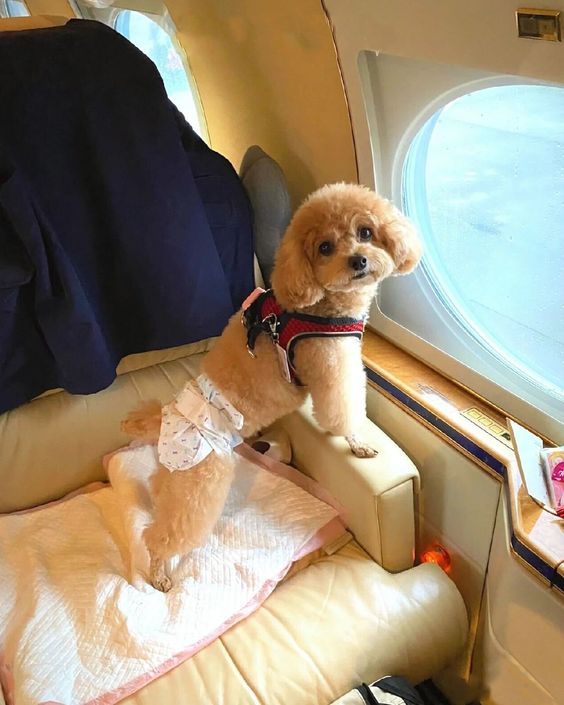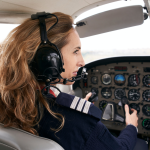Taking pets on trips can present certain difficulties. When it comes to flying with your furry companions, private jets provide a luxurious and convenient option that eliminates the stress of pet travel.
Pets should be treated like members of the family when traveling, as many people consider them to be such. Selecting a pet friendly private aviation company is the first step if you’ve never flown privately with a pet before.
When getting ready to take a pet friendly private jet charter, the following advice is also beneficial:

Think about the aircraft’s size
When choosing a private jet, consider its size to make sure your pets will have enough room to walk around comfortably.
Greater space on larger aircraft allows your pets to spread their legs and relax.
Consider whether the jet has a separate area or designated space for pets, which can increase their comfort during the flight.
We are pleased to help you choose the finest aircraft to carry your party of travelers, including your pets, if necessary.
Make sure your pet is prepared for the journey
The altered air pressure and cramped cabin can aggravate any underlying medical conditions that your pet may have, such as arthritis, heart problems, or breathing issues.
To make sure your pet is fit to travel, it is imperative to have them examined by an animal doctor thoroughly before the flight.
Your veterinarian may recommend medication to ease pain or discomfort and can offer advice on how to manage your pet’s health while traveling.

It is important to notify your veterinarian prior to the flight if your pet has a history of motion sickness when traveling in cars or other vehicles.
They may suggest suitable medications to help with motion sickness signs and make the journey more comfortable for your furry friend.
Pets may also experience anxiety disorders when flying, particularly if they are not accustomed to traveling or being in small areas.
Anxiety may increase motion sickness and cause additional behavioral problems. If your pet is anxious during the flight, your veterinarian may recommend fragrance sprays, natural remedies, or anti anxiety medications.
Remember that specific rules might call for a veterinarian’s health certificate if you’re traveling abroad or across state borders.
This document indicates to your pet’s good health and suitability for travel. Ensure that you have the required paperwork well in advance of the flight.
Make a veterinarian appointment in advance of your vacation
If you want your pet to travel with you, make an appointment with your veterinarian to go over your itinerary and see if your pet is healthy enough to travel.
While it’s understandable that you want your pet to join you on the adventure, you must put their comfort, safety, and health first. Ask your veterinarian the following questions just before confirming the specifics of your flight:
Can I travel with my pet in good health?
Compared to young, healthy pets, older pets and those with cardiac, endocrine, or respiratory disorders are more likely to experience a health issue during a flight.
Consult your veterinarian about your pet’s medical history to make sure they are well enough to fly.
Is my pet’s temperament right for a plane?
Even though your pet is healthy enough to fly, you still need to take their temperament into account. Most pets find flying to be an unfamiliar experience, so calming supplements or antianxiety medication may be helpful if your pet exhibits signs of anxiety when in unfamiliar situations. Your pet might have to forego the trip if they are very nervous.
Will the trip be beneficial for my pet?
Review the location and see if pet friendly accommodations and activities are offered before determining whether or not to take your pet on vacation.
If not, your pet might feel better about being boarded or spending your absence with a friend or relative.
Your veterinarian will give you your pet’s health certificate, vaccination records, and medical records all of which most airlines require if your pet is fit to travel.
If your pet will be staying behind, a boarding facility might require the same paperwork from you. Find out which medical records are necessary for the facility.
If you would like, get your pet used to being in a carrier
The fact that your pets won’t have to endure a long flight in a carrier or, worse, a carrier in the cargo hold is one of the biggest advantages of flying private with them.
However, depending on your pet’s personality traits or breed, you may want to use a carrier to ensure their comfort and safety.
If you will be using a carrier, it may be beneficial to acclimate your pets to their carriers in the days throughout the process up to the flight.
Allow them to explore and associate the carrier with happy memories by leaving it open in their living area and filling it with toys or treats.
They will feel less nervous and more at ease on the trip as a result. After boarding, make sure the carrier is firmly affixed and placed in a stable section of the cabin.
This keeps your pet from moving around needlessly while in flight and gives them a sense of security.
Temperature control
Make sure your pets are at an appropriate temperature inside the cabin. Although most private planes have temperature control abilities, it’s best to let the crew know ahead of time about your pets’ requirements.
Remember that traveling in extremely high or low temperatures can be harmful to pets, so it’s critical to make sure they are in a comfortable environment the entire way.
Keep in mind the basic needs
Make sure you have everything you’ll need for the flight, including food, snacks, medicine, and other necessities before you take off.
To avoid digestive problems, feed your pet exactly what they normally would. Don’t forget to pack their favorite blankets or toys for a little extra warmth on the trip.
Be relaxed with your pet
No matter how well prepared you are, unexpected challenges may still occur when traveling with your pet. Stay positive and able to adapt, acknowledge that you are trying your hardest, and understand the things that are out of your control.
When you plan your trip, put your pet’s safety first. You’ll both love the adventure and the eternal memories you make.
Taking your pet on vacation with you can create wonderful memories, especially if you plan ahead of time.
Recall that the majority of airlines demand that you bring the original health certificate for your pet, which must be signed and issued by a licensed veterinarian no later than ten days before your departure.
Find an animal doctor’s office nearest to your location and make sure your pet is prepared.
What documentation do we need to fly with a pet?
The requirements may vary based on the location (local or international). However, the standard checklist for taking pets on flights includes:
- Passport for pets
- Current vaccinations
- Whether dogs have received treatment for infections
- Documentation for microchips
- A certificate of animal health suitable for travel






